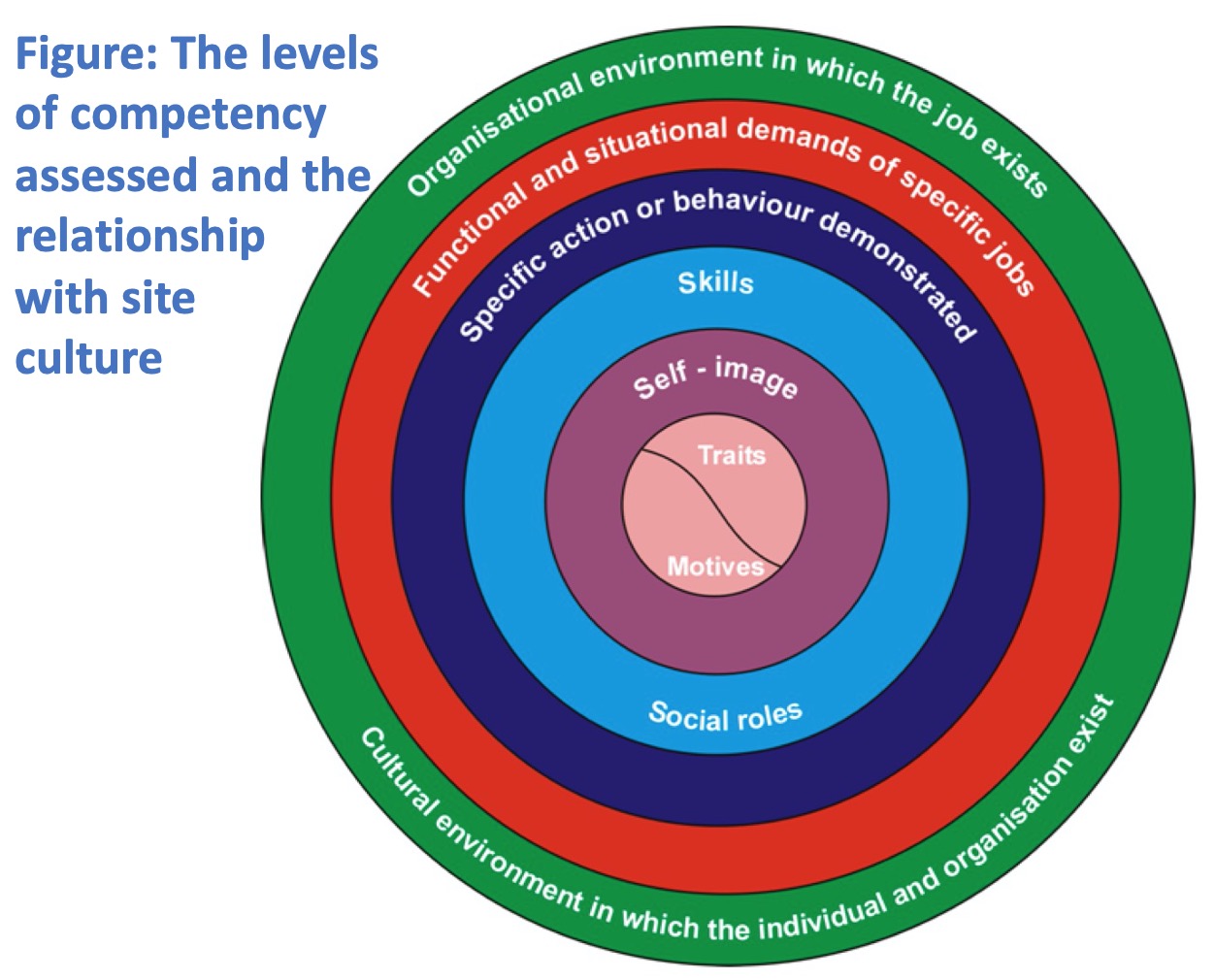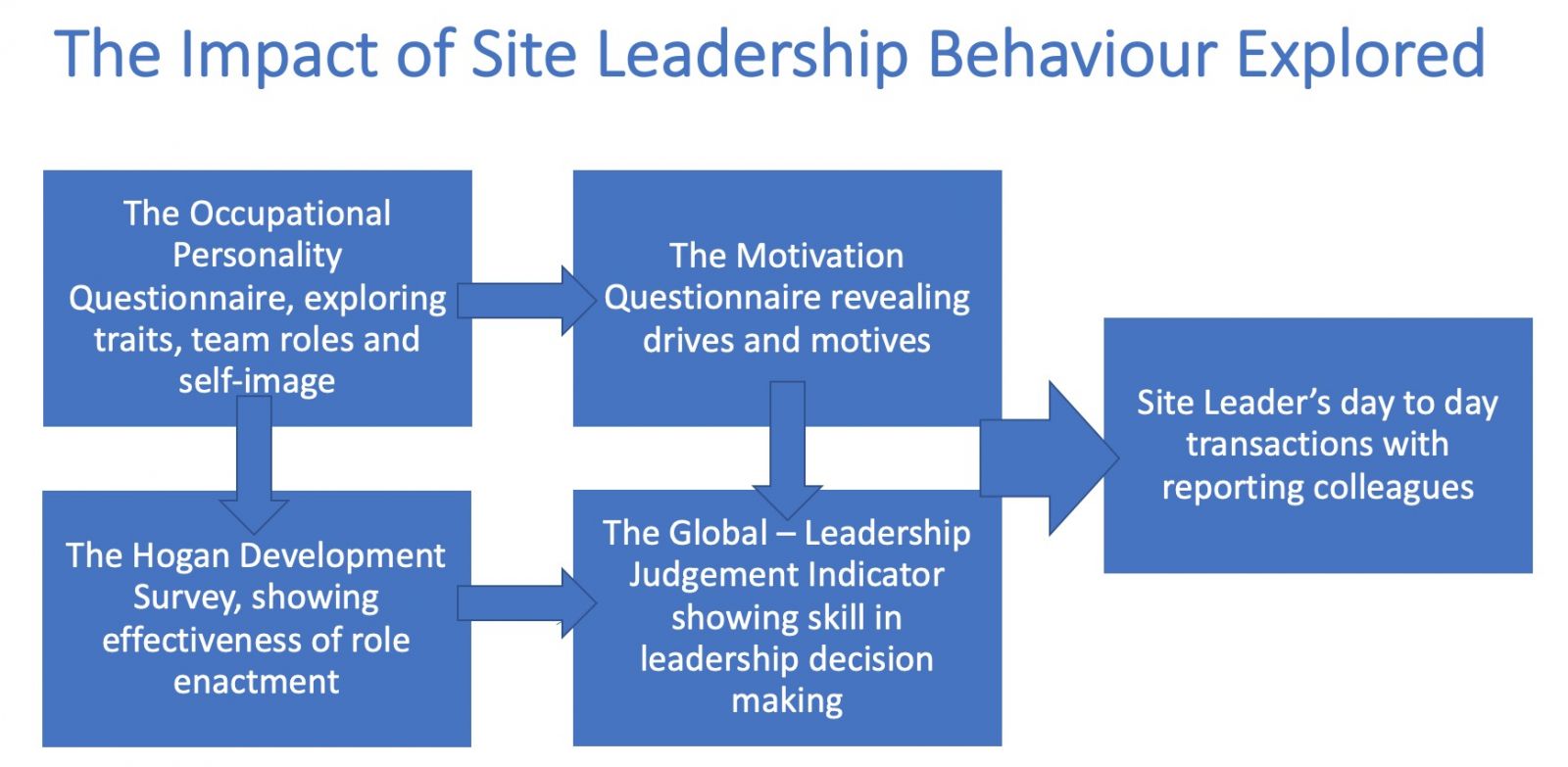Site Leadership Development
WHAT NEEDS TO CHANGE?
In any organisation there is a strong relationship between leadership behaviour, organisational health and productivity. Leadership behaviour is a key component in developing a high performance culture. The process described here seeks to pinpoint the exact qualities in site leaders that positively influence the culture on the site; similarly, it will show key barriers to progress that inhibit the site reaching its full potential. The Figure shows the main determinants of site culture; if leaders do not achieve an appropriate equilibrium between the four main orientations, then cultural problems will arise, impacting performance and productivity. By employing the process described below the site leader and senior colleagues can clearly identify where their leadership development priorities lie, which will enable them to lead the site more effectively through its cultural development journey.
 HOW WILL WE IDENTIFY THOSE NEEDS?
HOW WILL WE IDENTIFY THOSE NEEDS?
(1) The site leader completes a battery of tried and tested online psychometric assessments followed by (2) a personal one-to-one development discussion about the findings, which will include external high-performance benchmarking. This will enable the leader to (3) gain insight into their main strengths as well as barriers to achievement that are inhibiting cultural growth. These are then (4) presented to key stakeholders in order to confirm priorities and agree a development strategy. If more than one leader is being assessed then (5) a specially facilitated follow-on meeting is held which helps their understanding of each other, confirms joint priorities for action and gets all managers pointing in the same direction.
KEY FEATURES OF THE PROCESS
The process gains value as it is based upon (a) the previously identified characteristics of highly performing site leaders and people working at the most senior organisational levels; (b) previous job analyses by key stakeholders of site leadership positions; (c) the facilitation of Michael Lock, joint author of the internationally acclaimed Global-Leadership Judgement Indicator, who has much experience in the assessment and development of site leaders.
 WHAT DOES THE PROCESS ACTUALLY LOOK LIKE?
WHAT DOES THE PROCESS ACTUALLY LOOK LIKE?
The Figure illustrates the levels of competency explored by the assessment process. Through carefully layered exercises, testing and discussion, the impact of a site leader's traits, motives, self-image and social roles upon their behaviour will become obvious. This will offer insight into how they meet the demands of their job and its inevitable impact on the culture of the site.
Engaging in this exploration looks like this:
1. Telephone discussion between the site leader and Michael. This sets the scene, clarifies the process and confirms agreement to proceed (1 hour).
2. The site leader completes four online questionnaires, described below (2.5 hours).
3. A one-to-one, focussed development discussion between the site leader and Michael. The venue for this must be a closed and undisturbed training room environment, not the site leader’s office (3 hours).
4. Presentation of findings by the site leader and Michael to key stakeholders, who should include the HR Business Partner and line manager (1.5 hours).
5. If more than one site leader has been assessed, the next essential step is a facilitated meeting to compare and contrast individual profiles, agree the findings of the external benchmarking, collate the results and gain consensus about how to collaborate for success (3 hours).
6. Michael provides a psychometric signposting report on each person assessed, with executive summary, clearly outlining main strengths and development needs. The report includes an extended narrative illustrated by profile charts that benchmark the site manager against professional norms.
7. The site manager writes to key stakeholders with the agreed agenda for action, including (i) main strengths to be made more visible, (ii) the priority development need to be addressed, (iii) the additional support they will require and (iv) the timings for delivery, review and evaluation.

THE PSYCHOMETRIC PROFILES USED
1. The Occupational Personality Questionnaire (OPQ), which explores 32 characteristics relevant to success at work. These include how the site manager engages with other people, how they go about solving problems and the feelings and emotions that guide their behaviour. It allows styles of leadership and reporting behaviour to be discerned as well as team role behaviour (using the Belbin model). As the questionnaire has been used so extensively, much comparative data exists about the profiles of high performers in site management and production roles. [30 mins]
2. The Motivation Questionnaire (MQ), which explores 18 characteristics that can make a person work harder or less hard, depending upon circumstance. These drivers have a contagious impact on reporting staff and so readily influence productivity. This questionnaire also has a long history in the sector and a high-performance site manager profile is available for benchmarking purposes. [25 mins]
3. The Hogan Development Survey (HDS), which explores the site manager’s behaviour under pressure. It shows what strengths might be over-used under stress and become ‘too much of a good thing’, so undermining organisational health. The HDS is excellent for identifying themes for CPD and has been used extensively in site leadership development assignments. [25 mins]
4. The internationally acclaimed Global – Leadership Judgement Indicator (G-LJI) shows how well the site manager can flex away from the styles they prefer and interact with reporting colleagues in a way that suits the circumstances. As organisational health will be affected by the day-to-day transactions of the site manager with reporting colleagues, the G-LJI will indicate their ‘social discernment’ and the likely impact this will have on the evolution of site culture. [45 mins]
EXAMPLE SITE MANAGER CASE STUDY
'As a Site Leader who has engaged with Michael, I wholeheartedly recommend the process as a worthwhile development tool for all in leadership positions in a manufacturing environment. It’s easily the best personal development process I have come across, helping me, and also supporting the work we were doing to change the team, and our site’s culture. Having completed the online questionnaires, I was surprised at where the subsequent conversation with Michael took me. His ability to ask pertinent questions about previous events led me to insights that, although unanticipated, seemed important and well worth exploring. Further discussions with my Line Manager and colleagues broadly supported these insights, refined the conclusions and helped me build a development plan. What I liked about the plan was its simplicity; a couple of actions in a relatively short timescale that made it achievable. Because a number of members of my team have also been through the process, we were able to support each other as we came across the inevitable challenges we faced in implementing our plan.'
MICHAEL LOCK’S APPROACH
Michael has considerable experience in working at the most senior organisational levels. He is sensitive to the rapport that needs establishing with senior managers and their colleagues to ensure that all engage positively with a process such as this. Further, his collaborative approach ensures that participants develop a sense of ownership over their results and recognise its relevance to their continuing professional development. In this manner, full leverage of learning outcomes is sought and obtained to create optimal impact at individual, team and organisational levels.
PROFESSIONAL ARRANGEMENTS
Michael is, at all times, bound by the Code of Conduct of UK’s Health Care Professions Council (HCPC). Michael understands his duties to his clients and will, at all times, and to the best of his ability, seek to act in their best interests. The professional fee for Michael's activity surrounding the assessment for development is likely to be one day of professional time for each person assessed. Additional to fees will be travel, hotel expenses and costs of administration, profiling and report building of psychometric materials.
Another Site Director says, 'I think the use of your process to select people in the roles within a site leadership team, including the team leader, must also be emphasised. The insight your process produces in this situation is not just good for selection for the position, it also sets the individual away with a custom built development plan for the situation with commitment from both parties to deliver on it.'
Michael Lock Cert Ed, BA(Hons), MA, MSc is registered with the Health Care Professions Council (HCPC) as entitled to practise as an Educational Psychologist and an Occupational Psychologist. He holds a current Health Care Professions Council Practising Certificate, registration number PYL23504
